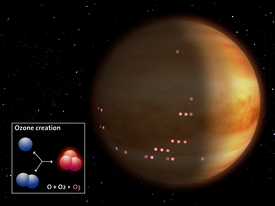Major Discoveries by Venus Express: 2006-2014
6. Ozone layer
The ozone layer in Earth's stratosphere is well known, and traces of ozone (O3) were detected more than 40 years ago in the atmosphere of Mars, but until the arrival of Venus Express, no one knew whether Venus had a comparable atmospheric layer.
Using observations made with the Spectroscopy for Investigation of Characteristics of the Atmosphere of Venus (SPICAV) instrument, scientists were able to detect the presence of a tenuous layer of ozone gas in its atmosphere.
The ozone was detected by means of stellar occultations – analysing light from distant stars as it passed through different layers of the atmosphere. The method relies on the availability of stars in the line of sight, meaning that it yields an uneven coverage of the planet and is limited to the night side.
 |
| Artist's impression of Venus highlighting where the molecule ozone has been detected in the planet's atmosphere. Credit: ESA/AOES medialab |
According to the new data, ozone is located at varying altitudes in the Venusian atmosphere, between 90 and 120 km – compared with 15-50 km on Earth – and is always confined to a rather thin layer, measuring 5 to 10 km across. The ozone layer on Venus is also very tenuous – up to 1000 times less dense than that on Earth.
One surprise was the absence of ozone at the anti-solar point, where molecular oxygen is highly concentrated. Other studies based on Venus Express observations showed that sunlight illuminating the day side of the planet splits carbon dioxide molecules, liberating oxygen atoms. These are then carried to the anti-solar point, on the night side, by a strong wind which flows from the hot day side to the cooler night side.
Oxygen atoms transported to the anti-solar point give rise to molecular oxygen, so some production of ozone was also expected. However, none was found. The lack of ozone detected there can be explained if the molecules are destroyed by chlorine-based compounds, which are funnelled to the anti-solar point by the same mechanism that carries the oxygen there. The chlorine-catalysed destruction of ozone at Venus' anti-solar point may be caused by reactions very similar to those responsible for the Antarctic 'ozone hole' on Earth, highlighting the similarity of atmospheric processes on these two planets.
This is one of the major discoveries made by Venus Express during the last eight years. Read more on the following pages:
| Major discoveries by Venus Express: 2006-2014 |
|
#5. Snow on Venus? |
|
#6. Ozone layer |
|
#7. Water loss |

